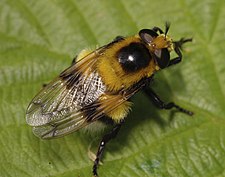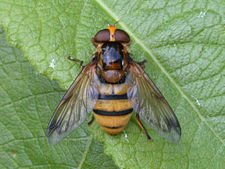Volucella: Difference between revisions
Content deleted Content added
No edit summary |
category |
||
| Line 14: | Line 14: | ||
==Selected species== |
==Selected species== |
||
| ⚫ | |||
{{col-begin|width=auto}} |
|||
{{col |
{{Div col}} |
||
*''[[Volucella anastasia]]'' <small>[[Frank Montgomery Hull|Hull]], 1946</small> |
*''[[Volucella anastasia]]'' <small>[[Frank Montgomery Hull|Hull]], 1946</small> |
||
*''[[Volucella bombylans]]'' <small>([[Carl Linnaeus|Linnaeus]], [[10th edition of Systema Naturae|1758]])</small> |
*''[[Volucella bombylans]]'' <small>([[Carl Linnaeus|Linnaeus]], [[10th edition of Systema Naturae|1758]])</small> |
||
| Line 36: | Line 36: | ||
*''[[Volucella unipunctata]]'' <small>[[Charles Howard Curran|Curran]], 1926</small> |
*''[[Volucella unipunctata]]'' <small>[[Charles Howard Curran|Curran]], 1926</small> |
||
*''[[Volucella zonaria]]'' <small>([[Nikolaus Poda von Neuhaus|Poda]], 1761)</small> |
*''[[Volucella zonaria]]'' <small>([[Nikolaus Poda von Neuhaus|Poda]], 1761)</small> |
||
{{col |
{{Div col end}} |
||
| ⚫ | |||
==Gallery== |
==Gallery== |
||
| Line 55: | Line 53: | ||
{{Taxonbar|from=Q1757472}} |
{{Taxonbar|from=Q1757472}} |
||
| ⚫ | |||
[[Category:Diptera of Asia]] |
[[Category:Diptera of Asia]] |
||
| ⚫ | |||
[[Category:Hoverfly genera]] |
[[Category:Hoverfly genera]] |
||
[[Category:Taxa named by Étienne Louis Geoffroy]] |
|||
Revision as of 18:28, 11 September 2021
| Volucella | |
|---|---|

| |
| Volucella pellucens | |
| Scientific classification | |
| Domain: | Eukaryota |
| Kingdom: | Animalia |
| Phylum: | Arthropoda |
| Class: | Insecta |
| Order: | Diptera |
| Family: | Syrphidae |
| Tribe: | Volucellini |
| Genus: | Volucella Geoffroy, 1762[1] |
| Species | |
|
See text | |
| Synonyms[2] | |
|
Macrostoma Swinderen, 1822 | |
Volucella is a genus of large, broad-bodied, dramatic hover-flies. They have distinctive plumose aristae and the face is extended downward.[3] They are strongly migratory and males are often territorial. Adults feed on nectar of flowers and are often seen sunning on leaves. The larvae of most species live in nests of bumblebees and social wasps, where they are detritivores and larval predators.[4]
Selected species
- Volucella anastasia Hull, 1946
- Volucella bombylans (Linnaeus, 1758)
- Volucella dracaena Curran
- Volucella elegans Loew, 1862
- Volucella eugenia Williston, 1887
- Volucella inanis (Linnaeus, 1758)
- Volucella inflata (Fabricius, 1794)
- Volucella jeddona Bigot, 1875
- Volucella linearis Walker, 1849[5]
- Volucella liquida Erichson in Wagner, 1841
- Volucella lutzi Curran, 1930
- Volucella matsumurai Han & Choi, 2001[5]
- Volucella nigricans Coquillett, 1898
- Volucella nigropicta Portschinsky, 1884
- Volucella pellucens (Linnaeus, 1758)
- Volucella plumatoides Hervé-Bazin, 1923
- Volucella suzukii Matsumura, 916 [5]
- Volucella tau Bigot, 1883
- Volucella unipunctata Curran, 1926
- Volucella zonaria (Poda, 1761)
Gallery
-
Volucella bombylans var. bombylans female
-
Volucella bombylans var. plumata female
-
Volucella inanis female
-
Volucella pellucens female
-
Volucella inflata female
-
Volucella zonaria female
References
- ^ Geoffroy, E.L. (1762). Histoire abregee des insectes ... de Paris. , . Vol. 2, . Paris: Durand. pp. 690 pp., pls 11-22. Retrieved 5 July 2021.
- ^ Evenhuis, Neal L. (2020). "The hazards of Nomenclatural Archaeology? The Diptera names of Theodorus van Swinderen in his 1822 Index Rerum Naturalium quae conservantur in Museo Academico Groningano". Zootaxa. 4859 (3): 383–396. doi:10.11646/zootaxa.4859.3.4. PMID 33056189.
- ^ Coe, R.L. (1953). Diptera: Syrphidae, Handbooks for the Identification of British Insects Vol 10 Pt 1. Royal Entomological Society of London. pp. 98pp.
- ^ Stubbs, Alan E. & Falk, Steven J. (1983). British Hoverflies: An Illustrated Identification Guide. British Entomological & Natural History Society. pp. 253, xvpp.
- ^ a b c Ichige, Katsuyoshi. "Japanese Hoverfly photograph collection". Mito-city, Japan. Archived from the original on 6 December 2012. Retrieved 5 August 2009.






